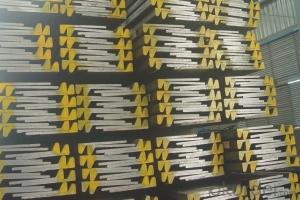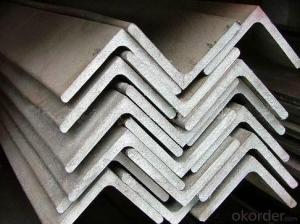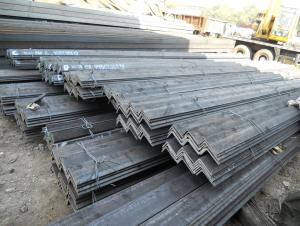Unequal Angle Steel Carbon steel L profile ASTM Standard
- Loading Port:
- Tianjin
- Payment Terms:
- TT or LC
- Min Order Qty:
- 30 m.t.
- Supply Capability:
- 30000 m.t./month
OKorder Service Pledge
OKorder Financial Service
You Might Also Like
Product Description:
OKorder is offering Unequal Angle Steel Carbon steel L profile ASTM Standard at great prices with worldwide shipping. Our supplier is a world-class manufacturer of steel, with our products utilized the world over. OKorder annually supplies products to European, North American and Asian markets. We provide quotations within 24 hours of receiving an inquiry and guarantee competitive prices.
Product Applications:
Unequal Angle Steel Carbon steel L profile ASTM Standard are ideal for structural applications and are widely used in the construction of buildings and bridges, and the manufacturing, petrochemical, and transportation industries.
Product Advantages:
OKorder's Unequal Angle Steel Carbon steel L profile ASTM Standard are durable, strong, and resist corrosion.
Main Product Features:
· Premium quality
· Prompt delivery & seaworthy packing (30 days after receiving deposit)
· Corrosion resistance
· Can be recycled and reused
· Mill test certification
· Professional Service
· Competitive pricing
Product Specifications:
Sizes: 25mm-250mm | ||
a*t | ||
25*2.5-4.0 | 70*6.0-9.0 | 130*9.0-15 |
30*2.5-6.6 | 75*6.0-9.0 | 140*10-14 |
36*3.0-5.0 | 80*5.0-10 | 150*10-20 |
38*2.3-6.0 | 90*7.0-10 | 160*10-16 |
40*3.0-5.0 | 100*6.0-12 | 175*12-15 |
45*4.0-6.0 | 110*8.0-10 | 180*12-18 |
50*4.0-6.0 | 120*6.0-15 | 200*14-25 |
60*4.0-8.0 | 125*8.0-14 | 250*25 |
Packaging & Delivery of Hot Rolled Unequal Angle Steel
1. Packing: it is nude packed in bundles by steel wire rod
2. Bundle weight: not more than 3.5MT for bulk vessel; less than 3 MT for container load
3. Marks:
Color marking: There will be color marking on both end of the bundle for the cargo delivered by bulk vessel. That makes it easily to distinguish at the destination port.
Tag mark: there will be tag mark tied up on the bundles. The information usually including supplier logo and name, product name, made in China, shipping marks and other information request by the customer.
If loading by container the marking is not needed, but we will prepare it as customer request.
4. Transportation: the goods are delivered by truck from mill to loading port, the maximum quantity can be loaded is around 40MTs by each truck. If the order quantity cannot reach the full truck loaded, the transportation cost per ton will be little higher than full load.
5. Delivered by container or bulk vessel
FAQ:
Q1: Why buy Materials & Equipment from OKorder.com?
A1: All products offered byOKorder.com are carefully selected from China's most reliable manufacturing enterprises. Through its ISO certifications, OKorder.com adheres to the highest standards and a commitment to supply chain safety and customer satisfaction.
Q2: How do we guarantee the quality of our products?
A2: We have established an advanced quality management system which conducts strict quality tests at every step, from raw materials to the final product. At the same time, we provide extensive follow-up service assurances as required.
Q3: How soon can we receive the product after purchase?
A3: Within three days of placing an order, we will begin production. The specific shipping date is dependent upon international and government factors, but is typically 7 to 10 workdays.
Q4: What makes stainless steel stainless?
A4: Stainless steel must contain at least 10.5 % chromium. It is this element that reacts with the oxygen in the air to form a complex chrome-oxide surface layer that is invisible but strong enough to prevent further oxygen from "staining" (rusting) the surface. Higher levels of chromium and the addition of other alloying elements such as nickel and molybdenum enhance this surface layer and improve the corrosion resistance of the stainless material.
Q5: Can stainless steel rust?
A5: Stainless does not "rust" as you think of regular steel rusting with a red oxide on the surface that flakes off. If you see red rust it is probably due to some iron particles that have contaminated the surface of the stainless steel and it is these iron particles that are rusting. Look at the source of the rusting and see if you can remove it from the surface.
Images:
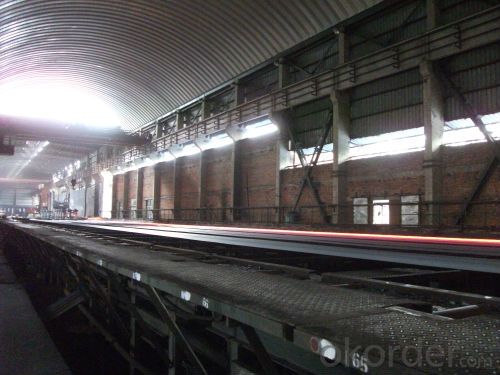

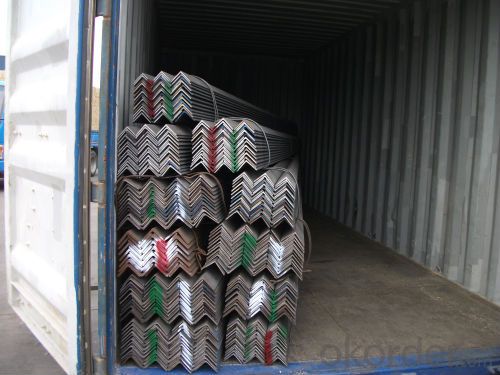
- Q:Can steel angles be used for fencing or security applications?
- Yes, steel angles can be used for fencing or security applications. Steel angles are commonly used in construction and are known for their strength and durability. When used for fencing, steel angles can provide a sturdy framework that can withstand harsh weather conditions and potential impacts. They can be welded or bolted together to create a secure and robust fence structure. Additionally, steel angles can also be used for security applications such as gates, barriers, and grills. The strength of steel angles makes them an ideal choice for enhancing security and ensuring the protection of a property.
- Q:Can steel angles be used for supporting mechanical equipment?
- Indeed, mechanical equipment can be effectively supported using steel angles. In construction and engineering endeavors, steel angles are frequently employed owing to their robustness, resilience, and adaptability. They furnish a steady and inflexible support framework for a wide array of mechanical equipment such as weighty machinery, conveyors, and support frames. Notably, steel angles are acclaimed for their capacity to bear weight, rendering them optimal for furnishing structural support in industrial settings. Furthermore, their L-shaped configuration facilitates effortless equipment installation and attachment. All in all, steel angles are a trustworthy and prevalent choice for bolstering mechanical equipment due to their strength, durability, and user-friendliness.
- Q:What are the different types of steel angles available?
- There are several different types of steel angles available, each designed for specific applications and purposes. Some common types include: 1. Equal Angle: Also known as L-shaped angles, these steel angles have equal side lengths and are often used for general structural and construction purposes. They provide excellent support and stability when connected to other structural components. 2. Unequal Angle: As the name suggests, unequal angles have different side lengths. These angles are commonly used in applications where one side needs to be longer or shorter than the other, such as supporting uneven loads or creating specific shapes. 3. Stainless Steel Angle: These angles are made from stainless steel, which is highly resistant to corrosion, making them suitable for applications where exposure to moisture or chemicals is a concern. They are often used in food processing plants, chemical industries, and marine environments. 4. Galvanized Angle: Galvanized steel angles are coated with a layer of zinc, providing excellent corrosion resistance. This makes them ideal for outdoor applications or areas with high humidity or saltwater exposure. 5. Rolled Steel Angle: Rolled steel angles are manufactured by rolling hot-rolled steel into the desired shape. This process enhances the strength and durability of the angle, making it suitable for heavy-duty applications. 6. Slotted Angle: Slotted angles have holes or slots along their length, allowing for easy attachment and adjustment. They are commonly used in shelving systems, workbenches, and storage racks, as they offer a versatile and customizable solution. 7. Structural Steel Angle: These angles are typically used in construction projects requiring load-bearing support. They are designed to withstand heavy loads and provide structural stability in buildings, bridges, and other infrastructure projects. It is important to consider the specific requirements of your project before choosing the appropriate type of steel angle. Consulting with a structural engineer or steel supplier can ensure that you select the right angle for your application.
- Q:Are steel angles recyclable?
- Yes, steel angles are recyclable. Steel is one of the most commonly recycled materials in the world because it retains its properties even after being melted and reshaped multiple times. This means that steel angles can be recycled and used to create new steel products. Recycling steel angles helps conserve natural resources, reduce energy consumption, and minimize the amount of waste that ends up in landfills. Additionally, the recycling process for steel is highly efficient and cost-effective, making it a sustainable option for the construction industry and other sectors that use steel angles.
- Q:Are steel angles suitable for vehicle ramps?
- Indeed, steel angles prove to be a fitting option for vehicle ramps. Renowned for their strength and durability, these steel angles are frequently employed in construction. Offering a robust and steadfast surface, they provide an appropriate selection for vehicle ramps. Furthermore, steel angles allow for effortless welding or bolting, enabling the creation of personalized ramp designs that cater to specific needs. In essence, steel angles present a dependable and pragmatic solution for the construction of vehicle ramps.
- Q:How do you store steel angles to prevent damage?
- Steel angles can be stored to prevent damage by ensuring they are stored in a dry, well-ventilated area, preferably indoors. They should be stacked on a flat surface and separated by wooden or rubber spacers to avoid direct contact and potential scratching. Additionally, storing them in an organized manner, with heavier angles at the bottom and lighter ones on top, can help prevent any potential bending or warping.
- Q:What is the minimum bend radius for a steel angle?
- The minimum bend radius for a steel angle depends on the specific dimensions and thickness of the angle. It is generally recommended to consult the manufacturer or reference industry standards to determine the appropriate minimum bend radius for a particular steel angle.
- Q:What are the different types of connections used for steel angles in residential applications?
- There are several different types of connections used for steel angles in residential applications. Some of the most commonly used ones include: 1. Welded connections: This is the most common type of connection used for steel angles. It involves welding the angle to the adjacent structural members, such as beams or columns. Welded connections provide excellent strength and rigidity, making them ideal for residential applications. 2. Bolted connections: Bolted connections involve using bolts and nuts to secure the steel angle to the adjacent members. This type of connection is often used when the angle needs to be easily removable or adjustable. Bolted connections are less rigid than welded connections but still provide sufficient strength for residential applications. 3. Clip connections: Clip connections are typically used to connect steel angles to wood or other non-steel materials. They involve using clips or brackets that are attached to the angle and then fastened to the adjacent material using screws or nails. Clip connections are commonly used in residential framing applications. 4. Gusset plate connections: Gusset plate connections are used when two steel angles need to be connected at a joint. A gusset plate, which is a flat plate of steel, is welded or bolted to the angles to provide additional support and rigidity. This type of connection is often used in residential roof trusses and other structural applications. 5. Cleat connections: Cleat connections involve using a steel plate, called a cleat, that is bolted or welded to the steel angle and the adjacent member. Cleat connections are commonly used when the angle needs to be attached to a horizontal member, such as a floor or roof joist. These are just a few examples of the different types of connections used for steel angles in residential applications. The choice of connection type will depend on factors such as the structural requirements, ease of installation, and the type of materials being connected.
- Q:Can steel angles be used in sports or recreational facilities?
- Yes, steel angles can be used in sports or recreational facilities. Steel angles are commonly used in the construction of various structures, including sports facilities such as stadiums, gymnasiums, and indoor arenas. They provide strength, durability, and support for the construction of grandstands, bleachers, and other seating arrangements. Additionally, steel angles can be utilized in the fabrication of equipment and fixtures like goal posts, basketball hoops, and fencing, further demonstrating their versatility in sports and recreational settings.
- Q:How do you design bracing using steel angles?
- When it comes to designing bracing using steel angles, there are several important steps to take into account. In the first place, it is crucial to ascertain the loads that the bracing will need to withstand. These loads can include vertical or horizontal forces, or a combination of both. Understanding the magnitude and direction of these forces is essential in order to design bracing that is effective. Next, it is necessary to select the appropriate steel angles. Steel angles come in various sizes and thicknesses, and the specific dimensions will depend on the desired strength and stiffness of the bracing. It is important to choose angles that can adequately resist the expected loads without experiencing excessive deflection or failure. Once the steel angles have been chosen, the bracing system must be designed to provide optimal stability. This involves determining the spacing and arrangement of the angles in order to ensure that the bracing effectively withstands the applied loads. The angles should be strategically positioned to create a stable and rigid structure. Furthermore, the connections between the steel angles and the main structural members must be designed with care. Adequate connections are crucial in transferring the loads from the bracing to the main structure. These connections should be strong, durable, and capable of transmitting both tension and compression forces. During the design process, it is also important to take into consideration any potential issues related to buckling or instability. Steel angles may be prone to buckling under certain loading conditions, and appropriate measures should be taken to prevent this. This can include adding additional bracing members, stiffeners, or using thicker angles if necessary. Lastly, it is crucial to consult relevant design codes and standards to ensure compliance with industry guidelines and regulations. These codes provide valuable guidance on the design, fabrication, and installation of steel bracing systems. To sum up, the process of designing bracing using steel angles involves determining the loads, selecting appropriate angles, designing an effective bracing system, ensuring proper connections, addressing stability concerns, and following relevant design codes and standards. By carefully considering these factors, it is possible to create a well-designed bracing system that provides the necessary support and stability to the structure.
1. Manufacturer Overview |
|
|---|---|
| Location | |
| Year Established | |
| Annual Output Value | |
| Main Markets | |
| Company Certifications | |
2. Manufacturer Certificates |
|
|---|---|
| a) Certification Name | |
| Range | |
| Reference | |
| Validity Period | |
3. Manufacturer Capability |
|
|---|---|
| a)Trade Capacity | |
| Nearest Port | |
| Export Percentage | |
| No.of Employees in Trade Department | |
| Language Spoken: | |
| b)Factory Information | |
| Factory Size: | |
| No. of Production Lines | |
| Contract Manufacturing | |
| Product Price Range | |
Send your message to us
Unequal Angle Steel Carbon steel L profile ASTM Standard
- Loading Port:
- Tianjin
- Payment Terms:
- TT or LC
- Min Order Qty:
- 30 m.t.
- Supply Capability:
- 30000 m.t./month
OKorder Service Pledge
OKorder Financial Service
Similar products
New products
Hot products
Hot Searches
Related keywords






